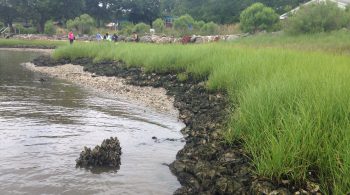
A private living shoreline on the Newport River
Waterfront property owners with eroding shorelines along our coastal sounds, bays, rivers, tidal creeks and waterways may soon be eligible for financial assistance to naturally control their erosion while increasing fish habitat at the same time.
The North Carolina Coastal Federation recently received grant funding from the National Oceanic and Atmospheric Administration (NOAA) Coastal Ecosystem Resiliency Grants Program to partner with waterfront landowners and marine contractors to promote and increase the use of living shorelines in the state. A living shoreline is a natural alternative to hardened shoreline structures, such as bulkheads or seawalls.
“Right now, most people armor their eroding shorelines with bulkheads or riprap,” said Dr. Lexia Weaver, coastal scientist with the North Carolina Coastal Federation. “Although temporarily efficient at preventing erosion, these structures quickly remove the valuable intertidal habitat seaward of them. At most locations, there are better environmental alternatives that also serve the needs of property owners.”
Living shorelines prevent erosion while maintaining the natural functions of the shoreline and protecting valuable salt marsh habitat.
“Typically, these shorelines have an offshore structure, or what we call a ‘speed bump for waves,’ that are made of wood, rock or recycled oyster shells. The area landward of the structure is then planted with native marsh grass.” Weaver said.
This combination is an effective erosion control method that maintains a thriving coastal ecosystem full of fish, crabs and other shellfish. Bulkheads, on the other hand, can lead to worsened erosion and often require costly repairs.
The funding from NOAA will allow the federation to partner with waterfront landowners to promote the use of living shorelines, resulting in increased coastal resiliency. This three-year grant aims to create at least 2,000 linear feet of living shoreline that will prevent erosion along both private and public properties. The grant funding will also be used to train marine contractors in the design and implementation of living shorelines.
Eligible shorelines must demonstrate specific erosion criteria and a need for shoreline protection. Selected landowners will receive a financial incentive as well as assistance with the design, permitting and construction of the living shoreline.
The federation has $75,000 available over two years to select 10-20 projects. A typical award per project will be around $5,000-$10,000 and will cover no more than 50 percent of the total cost of materials and labor.
“The federation will cost share selected projects with landowners to provide incentive for them to try this method of erosion control,” Weaver said. “We are confident that once someone installs a living shoreline, they will see the positive results for their property and the ecosystem. This will help us to encourage their wider use up and down the coast.”
Applications will be accepted through Friday, Sept. 2, 2016. Awards will be announced by Nov. 1, 2016.
Interested landowners should visit www.nccoast.org/
